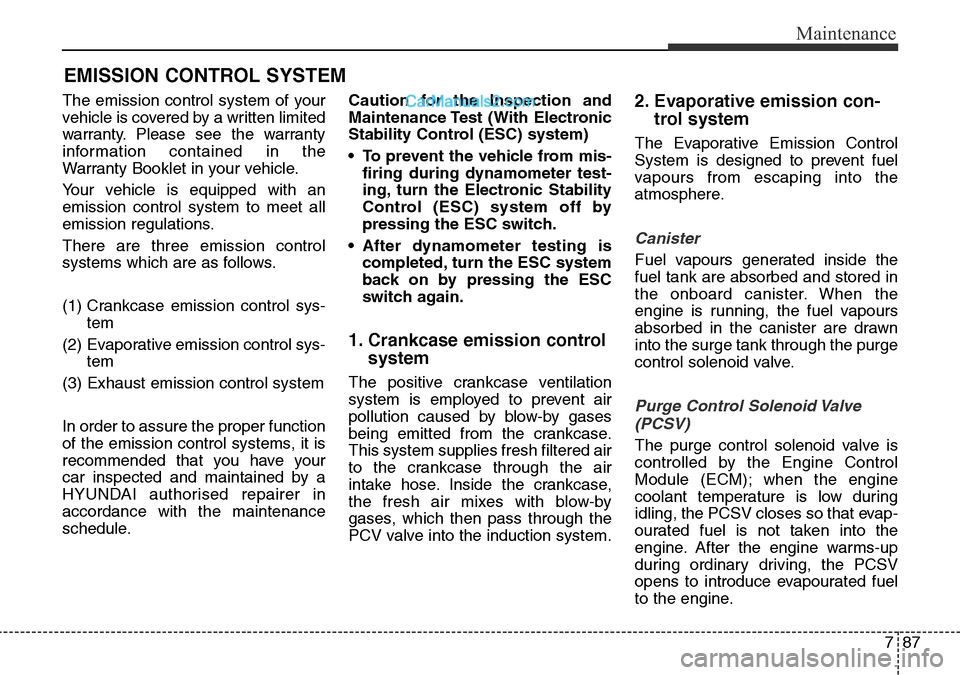Page 619 of 699

Maintenance
22 7
WASHER FLUID
Checking the washer fluid
level
The reservoir is translucent so that
you can check the level with a quick
visual inspection.
Check the fluid level in the washer
fluid reservoir and add fluid if neces-
sary.Plain water may be used if washer
fluid is not available.
However, use washer solvent with
antifreeze characteristics in cold cli-
mates to prevent freezing.
WARNING - Coolant
• Do not use radiator coolant or
antifreeze in the washer fluid
reservoir.
• Radiator coolant can severely
obscure visibility when
sprayed on the windscreen
and may cause loss of vehicle
control or damage to paint
and body trim.
• Windscreen Washer fluid
agents contain some amounts
of alcohol and can be flamma-
ble under certain circum-
stances. Do not allow sparks
or flame to contact the washer
fluid or the washer fluid reser-
voir. Damage to the vehicle or
occupants could occur.
• Windscreen washer fluid is
poisonous to humans and
animals. Do not drink and
avoid contacting windscreen
washer fluid. Serious injury or
death could occur.
ODMNMC2019
ODM072010
■Type A
■Type B
Page 684 of 699

787
Maintenance
EMISSION CONTROL SYSTEM
The emission control system of your
vehicle is covered by a written limited
warranty. Please see the warranty
information contained in the
Warranty Booklet in your vehicle.
Your vehicle is equipped with an
emission control system to meet all
emission regulations.
There are three emission control
systems which are as follows.
(1) Crankcase emission control sys-
tem
(2) Evaporative emission control sys-
tem
(3) Exhaust emission control system
In order to assure the proper function
of the emission control systems, it is
recommended that you have your
car inspected and maintained by a
HYUNDAI authorised repairer in
accordance with the maintenance
schedule.Caution for the Inspection and
Maintenance Test (With Electronic
Stability Control (ESC) system)
• To prevent the vehicle from mis-
firing during dynamometer test-
ing, turn the Electronic Stability
Control (ESC) system off by
pressing the ESC switch.
• After dynamometer testing is
completed, turn the ESC system
back on by pressing the ESC
switch again.
1. Crankcase emission control
system
The positive crankcase ventilation
system is employed to prevent air
pollution caused by blow-by gases
being emitted from the crankcase.
This system supplies fresh filtered air
to the crankcase through the air
intake hose. Inside the crankcase,
the fresh air mixes with blow-by
gases, which then pass through the
PCV valve into the induction system.
2. Evaporative emission con-
trol system
The Evaporative Emission Control
System is designed to prevent fuel
vapours from escaping into the
atmosphere.
Canister
Fuel vapours generated inside the
fuel tank are absorbed and stored in
the onboard canister. When the
engine is running, the fuel vapours
absorbed in the canister are drawn
into the surge tank through the purge
control solenoid valve.
Purge Control Solenoid Valve
(PCSV)
The purge control solenoid valve is
controlled by the Engine Control
Module (ECM); when the engine
coolant temperature is low during
idling, the PCSV closes so that evap-
ourated fuel is not taken into the
engine. After the engine warms-up
during ordinary driving, the PCSV
opens to introduce evapourated fuel
to the engine.
Page 694 of 699

87
Specifications & Consumer information
RECOMMENDED LUBRICANTS AND CAPACITIES
To help achieve proper engine and powertrain performance and durability, use only lubricants of the proper quality.
The correct lubricants also help promote engine efficiency that results in improved fuel economy.
These lubricants and fluids are recommended for use in your vehicle.
Lubricant Volume Classification
Engine oil *
1*2
(drain and refill)
RecommendsPetrol
Engine2.4L4.8 l(4.22 Imp. qts.)API Service SM *
3, ILSAC GF-4 or above
ACEA A5 (or above)
Diesel
Enginewith DPF *
46.3 l(5.54 Imp. qts.)
ACEA C3 or C2
without DPF *
46.3 l(5.54 Imp. qts.)
ACEA B4
Engine oil consumption Normal driving condition MAX. 1L / 1,500 km -
Severe driving condition MAX. 1L / 1,000 km -
Manual transaxle fluid 1.8 ~ 1.9 l
(1.58 ~ 1.67 Imp. qts.)API GL-4, SAE 75W/85
Automatic transaxle fluid Petrol
Engine2.4L7.1 l(6.24 Imp. qts.)MICHANG ATF SP-IV,
SK ATF SP-IV,
NOCA ATF SP-IV,
HYUNDAI genuine ATF SP-IV
Diesel
EngineR2.0L7.8 l(6.86 Imp. qts.)
R2.2L7.7 l(6.77 Imp. qts.)
Power steering fluid 1.0 l(0.87 Imp. qts.)PSF-4
Coolant
Petrol
Engine2.4L7.1 ~ 7.4 l
(6.24 ~ 6.51 Imp. qts.)Mixture of antifreeze and distilled water
(Ethylene glycol base coolant for aluminum
radiator)
Diesel
EngineR2.0L/R2.2L9.1 ~ 9.3 l
(8.0 ~ 8.18 Imp. qts.)